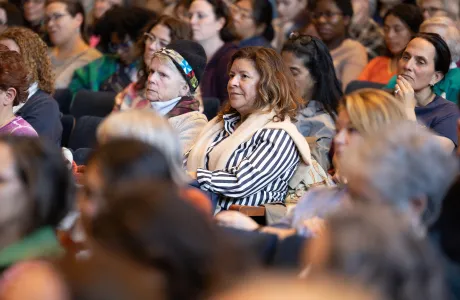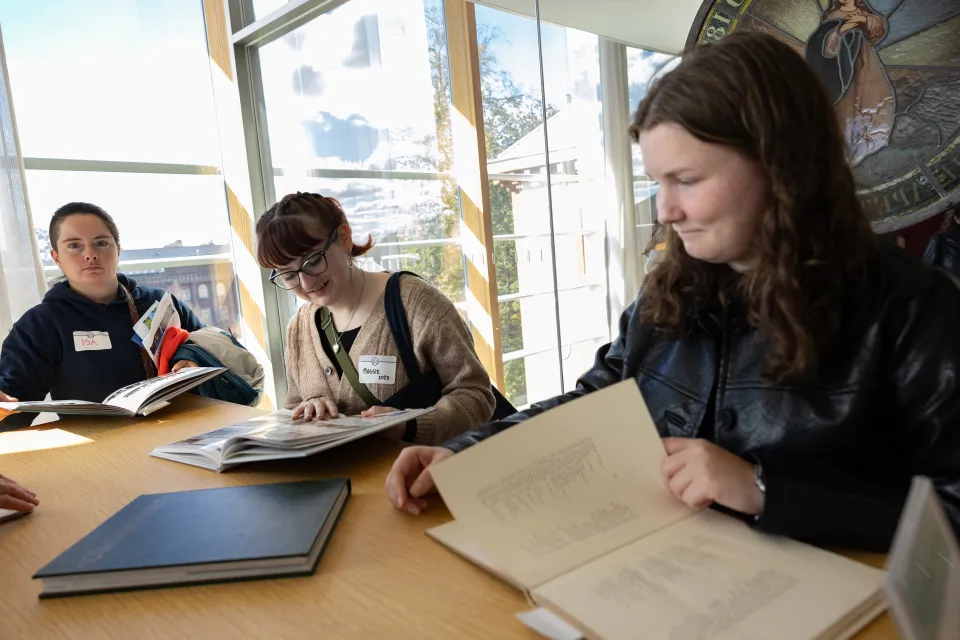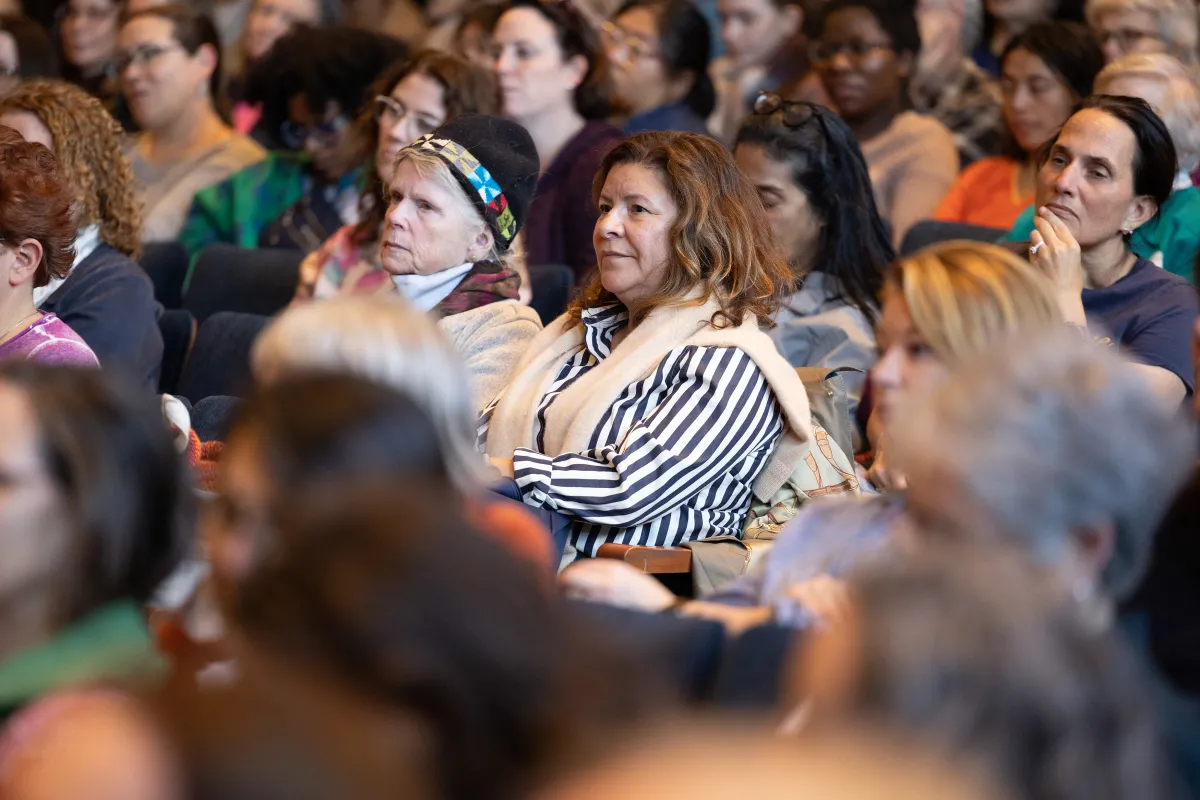Coming Home to Smith
Alum News
Nearly 700 alums and their guests returned to campus on November 1, 2025, for Come Home to Smith

Photo by Jessica Scranton
Published November 7, 2025
Nearly 700 alums and their guests returned to campus on November 1, 2025, for Come Home to Smith, a unique daylong celebration of the college’s 150th anniversary. Held on a dazzling and gusty Saturday over Family Weekend and coinciding with the inaugural gathering of Smith VOICES—a slate of alum-led workshops where a Variety of Opinions, Interests, Cohorts and Experiences were Supported—the autumn event was a lively but relaxed counterpoint to the college’s springtime Reunion.
Taking place while the academic year was in full swing, Come Home to Smith allowed alums to experience student life in action. The overlap with Family Weekend was also a happy reminder that, as one class of 2019 alum put it, “alums are part of the Smith family.”
President Sarah Willie-LeBreton reinforced this truth when she addressed an audience of alums from classes spanning eight decades, who had traveled from more than 20 states to reconnect with each other and the college: “The Smith story … lives on in every one of you, no matter how far from campus you are or how long you’ve been away.”
Pride Points and Performances
Alums started their day at the Alumnae House with coffee, refreshments, conversation, and sesquicentennial memorabilia. After that, they headed off to mix with students and their families at hands-on art activities, library exhibits, open houses, garden tours, and athletics events happening throughout the day. In addition to this living open curriculum, alums enjoyed free lunch served in the houses and at local food trucks assembled near Davis lawn.
The programming culminated in an address by President Sarah Willie-LeBreton at Sage Hall, where alums from Come Home, students and families, and Smith VOICES participants gathered to hear Smith’s 12th president reflect on Smith’s legacy and share her vision for where the college is headed.
The audience responded enthusiastically to pride points like Smith’s 8:1 student-to-faculty ratio, exceptional Fulbright success rate, and 41 self-governing house communities, “a model of democratic engagement that has defined Smith for generations.” The president took a moment to share Smith’s 150th celebration video before detailing the steps the college is taking to enact a future that is “even more intellectually daring, more creative, and more compassionate” than its remarkable past, including by waiving tuition for families making up to $150,000, the college’s latest advance in accessibility.
Student cultural groups including Moonlight Classical Chinese Dance and Blackappella underscored the emphasis on creativity and celebration with their vibrant performances.


New Ways to Connect
Besides the Alumnae House, the area outside of Davis House provided another gathering spot for Come Home alums. Hand-pressed cider, lawn games, and an upcycled bag-making workshop from the Design Thinking Initiative were just a few of the draws. The Center for the Environment, Ecological Design and Sustainability also offered an information session about Smith’s geothermal project and sponsored a kind of mini-Mountain Day on Davis Meadow, with donuts to accompany the fresh cider.
Like most alums in attendance, Susan Pelis ’87 enjoyed both the geothermal Q&A and the donuts. And like many alums “coming home to Smith,” Pelis said she was actively deepening her connections to Smith through new avenues beyond her milestone reunions, such as this event. An elementary educator in Massachusetts, Pelis said she had also recently started volunteering her time to interview prospective students for the college.
Enduring and Dynamic
Feelings of familiarity and change—the combination at the heart of most homecomings—were present for many returning Smithies.
At the Smith College Museum of Art, one alum headed straight to the third floor to see Auguste Rodin’s “Walking Man” sculpture, calling it “visiting an old friend.” Another alum couldn’t get over how much the museum had changed since she was a studio art major in the 1990s. And over at Neilson, Angelina Maxwell ’96 said the building was “almost unrecognizable.” “I used to avoid this place because I didn’t like the fluorescent lights here,” she said. “But now… What a beautiful building!” Alums also admired Kathleen McCartney Hall, a new home for career and leadership development.

Photo by Jessica Scranton
One alum agreed that “All the new buildings are spectacular, the museum and the library especially.” But happily, she added, “the houses are just the same.”
While the houses have retained their essential character, certain changes have been made to uphold Smith’s ongoing work toward diversity, representation, and inclusion. Visitors to a Special Collections exhibit on “Home, House, & History (and Halloween)” learned about the figures for whom five campus buildings were named last year, including Lee House (54 Green Street) for Carrie Lee, class of 1917. Lee had been denied on-campus housing as a Black first-year student, but as an alum had become a teacher and an advocate for the rights of women and people of color.
The Special Collections display included a yearbook opened to Lee’s senior page. A few feet away, alums were crouched on the library floor, going through the shelves of yearbooks to find their own senior pictures.
Scenes like these underscored the message of Come Home: that alums’ relationships to Smith are both enduring and dynamic—just like the college itself.

